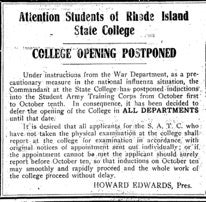KINGSTON, R.I. – May 27, 2020 – Following is an introduction to the Influenza pandemic of 1918 and its state impact, followed by a short question and answer section, from Catherine DeCesare, a senior lecturer in the University of Rhode Island Department of History. DeCesare is an expert in Rhode Island history and currently serves as history coordinator and academic advisor for URI’s Feinstein Providence Campus.
For a more in-depth discussion on pandemic policy parallels and the Rhode Island perspective, visit URI’s Social Science Institute.
The 1918 influenza pandemic in Rhode Island
The influenza pandemic struck Rhode Island hard in the late summer of 1918 and continued through the fall. As people and communities grappled with the emerging public health crisis, the confusion, shortages and unknowns paralleled other communities in the United States. It was a time of fear and of death situated in the midst of World War I.
Newport was the first Rhode Island community hit by Influenza. The disease made its way by means of navy transport ships to the port of Boston in early September 1918, and from there it spread to Newport’s military base. The virus crossed over to the civilian population, and travelled via community spread up Narragansett Bay. Soon it was everywhere– from northern parts of Rhode Island in the Blackstone Valley to South County- including the small community on Block Island. Congested urban populations living in poor housing conditions were disproportionately impacted, as were crowded military bases with new recruits. Influenza moved quickly, had many types of symptoms, and it especially attacked young adults.
Hospitals, doctors, and nurses were quickly overwhelmed and in short supply. In early September with more than 700 sailors afflicted, conditions at the Newport naval hospital became so crowded that sick navy men were transported to Providence’s St. Joseph’s Hospital. Soon thereafter, in Providence there were over 100 new cases divided between Rhode Island Hospital, St. Joseph’s and the City Hospital.
Public health officials, including Providence’s superintendent of health Dr. Charles V. Chapin repeatedly advised precautions and issued important public health advisories on how to prevent the spread of disease “keep away from crowds, the fingers are great carriers of germs, keep them away from nose and mouth, when taken suddenly with a cold, fever, pain…go right home and go to bed…respect the rights of others and if you have the grip stay at home so as not to spread the disease.” (Providence Journal Sept. 17, 1918)
What started in Newport quickly became a state public health concern with deaths among civilians reported throughout the state, including Pawtucket, Bristol, Westerly, Woonsocket, Portsmouth, Providence, and Newport. On September 26, the Aldermen for the City of Newport at the request of the health board closed the schools and revoked all licenses for entertainment. Other communities followed this protocol, albeit not without controversy and serious debate. Increased closures continued as conditions deteriorated.
In Kingston, the fall semester was postponed at the Rhode Island State College (now the University of Rhode Island). President Howard Edwards announced “as a precautionary measure in the national influenza situation…in consequence, it has been decided to defer the opening of the College in ALL DEPARTMENTS.” Likewise, in Providence, Principal Alger of the RI State Normal School (now Rhode Island College) announced the school’s closure due to the influenza epidemic.
(Providence Journal, Sept. 30, 1918)
By the middle of October, there were reports about the decreasing threat of influenza. Businesses, schools, clubs, and organizations started to reopen, including the Rhode Island State College in Kingston. Dr. Chapin continued to recommend precautions to safeguard against Influenza. The second wave of influenza declined by late fall 1918, but the third wave, albeit not as deadly as the second wave, was soon to erupt in the spring of 1919.
What are the similarities between the influenza pandemic and what we are experiencing now?
The similarities between the outbreak of influenza in 1918-19 and today’s pandemic include: the rapid spread of the disease and associated fears; the medical unknowns and lack of a vaccine; public health initiatives and concerns about overwhelming the healthcare system; the role of the government at the federal, state, and community level to tackle the crisis; the disproportionate impact on lower income, urban populations; the overall impact on individuals and families -physically, emotionally, and economically; even supply shortages.
How did society recover from these outbreaks? What were the lasting repercussions?
The influenza pandemic occurred in three waves (late spring/early summer 1918 which had minimal impact, fall 1918, and again in spring 1919). The worst was in the fall of 1918 – still in midst of World War I. The war effort, and all that it entailed, was the top priority for the US government and the Wilson Administration. The deaths of so many young people had lasting repercussion on families and on society as a whole. The disillusionment of war and death greatly impacted the decade of the 1920s.
What can we learn from these previous experiences in terms of what was handled well and what wasn’t?
Public health policy in 1918 was hampered by staggered and inconsistent implementation throughout the state. This was even more apparent at the federal level.
Mitigation including proactive quarantining protocol, washing hands, keeping hands away from the face, and the use of masks – all work. Allocating sufficient resources for additional medical personnel, equipment and facilities works.
Second and even third waves of the pandemic are possible.
If history is any guide, how do you see the United States (or the world) getting through this? What should we be prepared for?
Then as now, the concept of equality remains elusive. In any crisis there are survivors and fatalities, and demographics often play a decisive role in the outcome.
Historical research can be applied to better understand contemporary issues, and historians can increase awareness to guide and to develop improved public policy.


